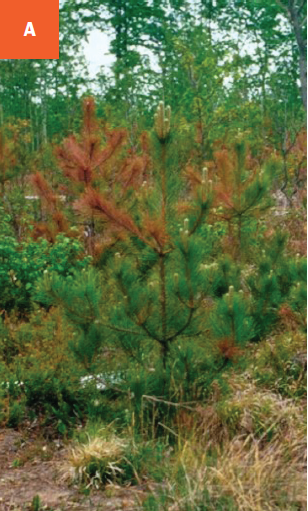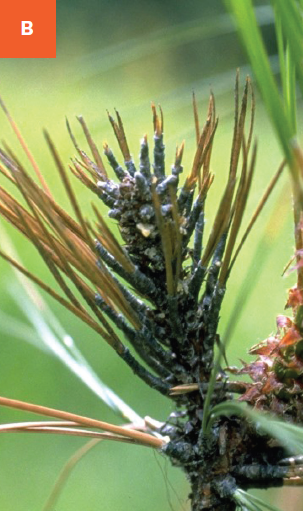Diplodia Tip Blight
Diplodia pinea (fungus)
HOST Two- and three-needle pines (Austrian, Scots, and Mugo pine), fir, spruce, juniper
DAMAGE/SYMPTOMS Initial infection may cause large amounts of resin to ooze out of branches. Black fruiting bodies are visible at the base of infected needles late summer to fall. Current year branch tips turn brown and die. New needles may appear stunted and change color from yellow to brown. Cankers may develop on branches. Symptoms are more severe on lower branches and infection may kill trees over time. Trees 30 years and older and weak trees are more prone to infection.
DISEASE CYCLE The fungus survives in infected needles, branches, and cones. In late spring to early summer, fruiting bodies discharge spores during wet conditions which infect young needles of the current season. The fungus grows within the needles and moves towards the base of needles and eventually into the twig. Infected needles turn brown and cankers are produced on the twigs/branches.
MANAGEMENT Focus on supporting tree vigor and provide adequate water and nutrients during the growing season. Remove and dispose of fallen needles, cones, and infected branches during dry weather. Spores can invade branches through wounds, therefore avoid pruning trees from late spring to early summer. Disinfect pruning tools with 70% ethyl alcohol or a standard household disinfectant spray before each cut to minimize spreading the disease. Fungicides with the active ingredient thiophanate-methyl, propiconazole, or chlorothalonil may be applied at budbreak, at half candle, and at full candle.
A Pine trees affected by diplodia. B Brown and stunted needles on young shoot. C Shoot tip dieback on pine tree. D Black fungal fruiting bodies on infected needles.




